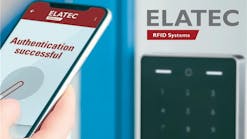The Zodiac-Lite Fingerprint Reader is a cost-effective and versatile biometric solution for single-door applications. All biometric programming and enrollment functions are performed at the Zodiac reader using a hand-held programmer.
Biometric access control is available in a variety of configurations using different biometric signatures and different methods of authentication. The Zodiac uses a fingerprint signature. The end-user is identified by his or her fingerprint.
Authentication refers to how the biometric device determines that the person requesting access is authorized. Some systems compare the biometric template (the data which a scanner obtains when a person interacts with a biometric reader) with a remote database of templates (which represent the users enrolled) and validates the access based on privileges assigned to the particular user. This is referred to as 1: many authentication. It requires real time communications between the biometric scanner and the device where the database is stored and access decisions are performed.
Another technique used to authenticate a user is to require that the person present a credential when requesting access. The biometric signature scanned is compared to the template stored on the credential, then tested against the list of authorized users.
Another method requires the user enter a PIN (personal identification number). The biometric template has been previously enrolled into the database and a unique PIN is associated with that code.
The Zodiac-Lite stores biometric template right at the door. When a person presents a finger to request access, the device compares that signature with those stored in memory and if there is a match, grants access. The Zodiac-Lite has a 90-user capacity, so it is a 1:90 authentication. The user simply places his or her finger on the scanner for quick access to the door or device being controlled.
Benefits of this technique are:
No external wiring or real time communications required to interrogate a database.
No keypad or reader, therefore no PIN or credential.
Using only a finger for access fulfills the promise many people expect from biometrics - no interaction with the system other than a biometric one.
The Zodiac-Lite generates a unique Weigand data stream for each fingerprint enrolled in the system. Therefore if the application requires activity logs or time zones, the Zodiac-Lite reader can be interfaced with an appropriate controller which supports enhanced access control features.
No Fingerprints. No problem!
With all biometric products, a small percentage of people cannot be biometrically enrolled. For these individuals, a Zodiac Bypass Key can be programmed and issued. Users presenting a Bypass Key will not be required to scan their fingers. Each system comes with five Bypass Keys and additional keys can be ordered from Cansec.
Door Controller and Audit Retrieval
For clients requiring historical audit data, the Zodiac Lite door controller can be used with Cansec’s SmartLock UltraLite access control software. Each door controller stores up to 1,000 time and date stamped transactions in memory which can be retrieved using the optional SmartLock UltraLite Programming Kit. This audit data can be uploaded and viewed on a host PC.
Zodiac-Lite can be used for many other applications besides traditional door access control. The Door Controller activates a relay on valid authentication which can be used to control other devices such as lockers, safes, and other types of equipment.
For more information on Cansec products, contact your local locksmith distributor or Cansec Systems, telephone 905-820-2404. Web Site: www.cansec.com.
RP15 multiCLASS™ Reader
Access control, like all other security technologies, is in a constant transition. FIPS 201/ HSPD 12 calls for the implementation of a smart card initiative, the goal being to produce a common identification standard for all federal government employees and contractors.
The RP15 is a multi-technology card reader designed for customers upgrading their current card system from some of the most popular proximity formats to iCLASS® credentials.
With the RP15 reader, the customer has the ability to transition to smart cards over time while incorporating the use of multiple card technologies within a single building or across multiple facilities.
One of my clients is a subsidiary of a large corporation which engages in activities subject to Department of Defense regulations.
When Corporate Security recently announced the rollout of an enterprise-wide FIPS 201 compliant credential, there was a certain degree of anxiety. (This announcement was greeted as a sort of unfunded mandate by certain entities among the corporate citizenry)
But such a rollout was inevitable and made a lot of sense. Besides achieving compliance with FIPS 201, the new credentials would allow corporate members to be able to travel throughout the enterprise knowing their credential would grant them access and make for a far more secure environment.
Using readers such as the RP-15 multiCLASS Reader allows for seamless integration without having to totally retool their EAC system.
The RP15 multiCLASS reader was specifically designed to assist customers with the transition from the popular HID MiniProx® and other mullion mounted reader form factors. The RP15 features the same mounting dimensions as the MiniProx to allow for an easy direct replacement.
The multiCLASS family of products provides true iCLASS security, the ease of Prox and the power of smart cards.
Simple Migration from the most popular proximity technologies to iCLASS® Open Architecture Design allows project specific formats and keys and provides flexible options for processing multi-technology cards and configuring the reader’s audio/visual characteristics.
Reads:
125kHz – HID, Indala, EM4102 or AWID proximity
13.56MHz – iCLASS, ISO 15693 CSN (MyD, ICODE, Tag it), ISO 14443A CSN (MIFARE, DESFire), US Government PIV, ISO 14443B CSN, FeliCa™ IDm, CEPAS CAN or CSN
Tim O'Leary
Tim O'Leary is a security consultant, trainer and technician who has also been writing articles on all areas of locksmithing & physical security for many years.





